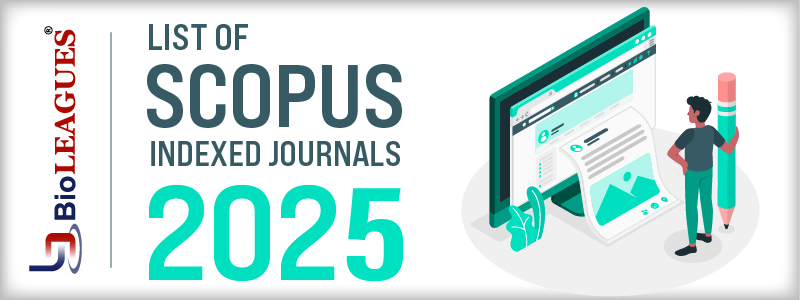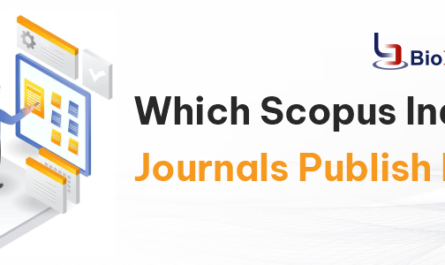Journal publication in a reputable, high-impact indexed Scopus journal is the primary metric for anyone – whether they’re someone who wants to read the best journals to gain knowledge on the biggest and most prolific research studies or a researcher who wishes to have his/her research work published in a manner that their article gets the maximum reach and exposure possible. However, choosing the right journal can be a complex task. One must optimize between different criteria before making a decision. The journal selection process involves various factors –
- identification of the scope of the journal,
- impact factor,
- the reputation of the journal,
- specific indexing,
- periodicity of publication of issues, and
- open access fees/publication fees.
Scopus – What’s All The Hype About?
- Scopus is one of the most prominent and largest indexing databases of journals and books in the academic world.
- Some of the benefits of publishing in Scopus indexed journals include –
- increased visibility of one’s publication(s),
- the rigorous peer review process, and
- reaching a global audience.
- Scopus is the most recommended database because researchers can easily find relevant and reliable research and access data that can help them select the most appropriate journal for their research article.
- The research publishing industry has grown significantly, and a new journal is launched almost every day.
- Therefore, it is necessary to identify and eliminate underperforming and predatory journals from the list while selecting the right journal to publish.
- Scopus is a journal database that includes only –
- reputable,
- high-performing,
- high-impact,
- peer-reviewed journals.
- Journals or publishers added to the Scopus list undergo a rigorous review process by subject matter experts from the Content Selection and Advisory Board (CSAB).
- The board determines title eligibility and removes underperforming and predatory journals.
- The board of trustees and Committee on Publication Ethics (COPE) decide whether to include a new journal, remove an indexed journal, or continue with a journal.
- Scopus and CSAB ensure that users get the best possible evidence for their work and that only trustworthy journals and their content are available to researchers.
- For years, having published research has been a requirement for most scholars wishing to become tenured at their respective universities and higher education institutions, but recently it has become more common for universities to only recognize research published in prestigious indexed and abstracted journals.
- These necessities stem from the fact that the indices give specific measures that rank the success of the journal and the impact of each author’s citations.
- High ratings assist authors and their affiliated universities in gaining recognition within the academic community and in accessing greater research funding, which helps their careers and programs thrive.
- Some of the most popular indexes and summary services include –
- Web of Science,
- Scopus,
- INSPEC,
- PsycInfo and others.
- Because of the prestige of these indexes, included journals receive a greater number of submissions for each issue, increasing competition for each coveted spot in the journal.
- With greater competition comes higher quality papers in the submission queue and lower acceptance rates, which means it’s much harder to get accepted into these publications than those that are not yet indexed.
- The indexing push means that for many scholars, the stress of getting their research published goes far beyond just getting accepted.
- All journals demand their submissions to be polished and ready for peer review, indicating that it can be a pivotal mistake not to have one’s manuscript professionally reviewed before submission.
- Fortunately, there are many professional services, such as Bioleagues, available to help authors and researchers at every stage of their publishing journey by offering comprehensive and professional editorial services, including editing and proofreading, and journal selection.
- Bearing the stress of indexing in mind, we recognize that not all researchers are indexing experts, even if their careers rely on index inclusion.
- So, this article offers a comprehensive insight into one of the biggest indices, Scopus, and all of its requirements.
The Constant Reassessment Of Journal Quality
- In addition to the selection criteria, there is a continuous process of monitoring and reassessment, which ensures that the quality of indexed journals must be maintained.
- Four criteria are considered for the re-evaluation of an indexed journal –
- the overall performance of the journal since its indexing or since the last assessment was carried out;
- the standards of the peer review and publication processes since its indexing or since the last assessment was carried out;
- the quality of data retention since its indexing or since the last assessment was carried out;
- all vital data metrics, including –
- periodicity,
- number of original articles,
- diversity,
- novelty,
- etc.,
since its indexing or since the last assessment was carried out.
Poor Journal Performance
- A journal’s underperformance is determined by analyzing three metrics –
- Self-citation rate (more self-citation)
- Total citation rate (minus citations)
- CiteScore (Lower CiteScore compared to any other peer-reviewed journal).
- In conclusion, the information or data provided by Scopus is strongly recommended, and therefore, it is necessary for this purpose of indexing to provide reliable content, to include reputable journals (excluded in a predatory manner), and to update the database regularly.
The Origins Of Scopus
- Founded by Elsevier in 2004, Scopus has quickly grown into the largest index and citation database in the global market today.
- Scopus is comprised of research in a wide variety of interdisciplinary subjects but classifies all their content into four categories –
- the health sciences,
- the life sciences,
- the social sciences, and
- the physical sciences.
- It also includes a wealth of research from –
- over twenty thousand peer-reviewed journals;
- over one hundred thousand books; and
- features over seventy million articles and chapters.
- Although such an important index, each publication included in the Scopus database is subject to a period of rigorous review to verify its quality and contribution to the scientific community.
Why Is Scopus Considered So Special?
With its status as the largest index in the market, many universities are beginning to require their professors to publish in journals featured in Scopus in order to publicize their prestige as a university and also draw attention to new students as well as acquire research funding. Although Scopus does not feature things like the Web of Science Funding Data Index, Scopus does have a variety of features that set it apart from Web of Science and other influential indices. These unique features include –
- The Treasure Trove Of Historical Content That It Consists Of
Scopus features curated content dating back to 1788.
- A Highly Selective Advisory Board
- The Scopus CSAB (its Content Selection and Advisory Board) only accepts approximately 630 of 3,500 annual submissions, proving that it provides only the highest quality research in its index.
- The criteria Scopus uses to judge reviews and publications are extensive and include things like –
- Consistent posting;
- ISSN;
- Content readable by an international audience (titles/abstracts in English, roman letters in citations);
- Statement of ethics and professional malpractice of publication accessible to the public;
- Presence of peer review;
- Diversity of authors and publishers;
- Convincing editorial policies;
- Contribution to the academic field;
- Clarity of summaries;
- Compliance with objectives and scope;
- Readability of articles;
- Cited in other Scopus publications;
- Online availability;
- Quality of the journal’s web page.
- The Scrupulous Annual Review Processes That It Has In Place
Scopus even has an unwavering system in place that allows them to regularly re-evaluate indexed journals to ensure they meet Scopus guidelines. The six criteria that Scopus looks for in reassessment procedures are –
- The Self-Citation Rate
The journal has a self-citation rate of less than twice that of peer journals in its field.
- The Total Citation Rate
The journal received half or more citations than peer journals in its field.
- The CiteScore Rate
The journal has more than half the average CiteScore among peer journals in its field.
- The Number Of Articles
The journal produced half as many articles as the average journal in its field.
- The Number Of Clicks On The Full Text On The Scopus Site
The full text of the journal is used half as much as other journals in its field on the Scopus site.
- Use Of Abstracts On Scopus.Com
Abstracts are used half as often as peer reviews on the Scopus site.
- Creator Of Popular Quality Indicators
Scopus has its own collection of popular journal quality metrics, including –
- the H-Index,
- Scimago Journal Rank or SJR,
- CiteScore, and
- Source Normalized Impact per Paper or SNIP,
all of which are beneficial metrics for authors, editors, and publishers to gauge the success and reach of their content relative to other articles in their field.
How Does Scopus Incorporate Journals Into Its Database?
- Any scientific journal can be submitted for inclusion in Scopus through its publisher or editor-in-chief (EiC) using the Scopus title suggestion page.
- From there, the journal information is presented to the Scopus Content Selection and Advisory Board (CSAB).
- This council is made up of scientists, researchers, and librarians from around the world who specialize in specific fields.
- The board reviews journals based on criteria defined by Scopus and recommends acceptance or rejection of a journal.
- They also participate in the reassessment process to ensure that Scopus stays up to date with the most relevant content for the international academic community in each subject area.
- If indexing is a major concern for someone as an author, finding a journal that meets their needs is a top priority.
- Fortunately for them, they can avail themselves of the assistance of professionals such as Bioleagues.
- In order to use this free service and receive the most relevant Scopus journal list recommendations for their article, they need to simply get in touch with the Bioleagues team, who will then offer them comprehensive assistance with everything from choosing the right Scopus indexed journal 2025 for their career/research objectives and even submitting as well as getting successfully published by this journal.
What Are The Qualities Of Scopus That Make Its Journals Worth Pursuing?
Whether one is looking to choose a journal to read from and learn about the latest research studies, reports, and projects being undertaken by researchers belonging to their discipline all across the globe or to have their research findings published in such a manner that they get maximum exposure and publicity for all their hard work, considering the below-listed qualities of Scopus, will help them in realizing how and why Scopus journals seatch are so highly esteemed and sought after by both universities, research institutions, and veteran researchers themselves.
- The Academic Rigor Of The Journal In Question
- The first of many aspects of a Scopus indexed journal list to consider is the academic rigor of the journal.
- Scopus can be thought of as an abstract and citation indexing database of peer-reviewed literature – scientific journals, books, and conference proceedings that’s owned by the publishing house Elsevier.
- This provides a first clue to the sheer nature of its academic rigor – it demands that peer review be a pivotal part of everything indexed in it.
- Numerous other requirements must also be met by any journal that wishes to be recognized as a Scopus-indexed journal.
- Some of these requirements include –
- a rich diversity in terms of its geographic reach of publishers and authors;
- a proven academic contribution in its focus discipline;
- its content quality;
- its regularity of publication.
- In order to acquire more comprehensive insights into the selection conditions that Scopus adheres to, one can head over to the Scopus section of the Elsevier website, where they’ll find a ton of info.
- In addition to fulfilling these requirements for initial indexing, journals are reassessed annually and must demonstrate that they still meet the requirements.
- Thus, it is incumbent upon any indexed journal to also maintain academic rigor in the articles it accepts.
- Journals are even evaluated on their citation statistics – it is important that published articles are cited.
- Most scholars seeking tenure at their university are expected to have published research for years, but it has recently become more common for colleges to only recognize research published in prestigious indexed and abstracted journals.
- These limitations arise because the indexes provide explicit measures that rank the success of the journal and the citation impacts of each author.
- Authors, along with the universities that they’re affiliated with, having high ratings, earn academic respect and access to more research funds, making it possible for their careers and programs to grow exponentially.
- The Web of Science, Scopus, Google Scholar, INSPEC, PsycInfo, and other indexing and summarizing services are among the most popular.
- The included journals receive a higher volume of submissions for each issue due to the prestige of these indexes, which strengthens the rivalry for each coveted space in the journal.
- Higher quality articles in the submission queue and lower acceptance rates come with increased competition, making it much more difficult to be accepted into these journals than those not yet indexed.
- Owing to the need for indexing, the stress of publishing research for many scholars goes far beyond just being accepted.
- All journals expect polished submissions ready for peer review, so not having one’s work professionally reviewed before submission can prove to be quite a costly mistake that, as a matter of fact, is not all that hard to avoid in the first place.
- The quality of a scientific journal is determined by its indexing.
- Compared to non-indexed publications, indexed journals are considered to be of higher scientific quality.
- Indexed journals have a greater online presence, better discoverability of articles and are known to publish high-quality articles in their respective disciplines.
- The more a journal is indexed (particularly in prominent journal indexing databases), the more likely it is to be found, read as well as also cited in library databases.
- This means that a researcher’s published articles have a better chance of being discovered, read, and eventually even cited.
- Every indexing agency targets a slightly different readership, making it possible for journals to reach a wider audience.
The Typical Publishing Process Of A Scopus Indexed Journal
Here are the guidelines for publishing one’s research in any old or upcoming Scopus Indexed Journals.
- Identifying Relevant Scopus Journals That Are Suitable Enough To Have Your Work Published In
- The first step is to find relevant journals that are indexed by Scopus.
- How to find the relevant Scopus indexed journal?
- In recent days, hundreds and thousands of international Scopus indexed journals in all fields have cropped up.
- Therefore, it might be a bit difficult for a person to find the relevant Scopus-indexed journal by just browsing the main Scopus-indexed journal list.
- To this end, Scopus has created a means for users to search for journals that match their discipline of interest by simply entering certain details, as shown below.
- Determining Those Journals That Fall Within Your Specific Niche
- The specific title of the publication or journal for which they are looking for the name of the publisher as well as the ISSN code.
- Any of the details mentioned above can be entered correctly in order to help the user discover the publication or journal that is listed in the main Scopus list.
- On the other hand, if one doesn’t know the details mentioned above, they don’t have to worry.
- They can also expand their search without entering these details by simply entering the area of interest.
- The only drawback is that this might take some time.
- At the same time, it is also easy because Scopus offers many options to minimize your search.
- Shortlisting The Best Scopus Indexed Journal
- Now you may have found the ways to find the Scopus indexed journals. But, finding the best of them is vital.
- Detailed below are the crucial steps to consider in order to do this.
- Simply, publishing the research work in one of the publications or journals is the worst way to publish.
- A researcher should always begin by finding the most relevant and suitable journals for their current area of interest or study.
- As mentioned earlier, Scopus has several journals as well as publications that are listed as a part of the main list and are considered to be of good quality, reliable and genuine.
- Finding the relevant and best-suited Scopus indexed journals 2025 to publish the research paper also involves a few steps to follow.
- The number of subscribers or readers a newspaper has;
- The topic or title that a journal covers;
- The level of researchers or authors who have their research paper published in that particular journal;
- The opportunities or chances that can be acquired as a result of the publication of the writing of the research paper;
- Their popularity and reputability within one’s domain or discipline;
- To find out whether the specific journal is an open access journal or closed access journal.
- When a decision has to be made, such as choosing an open access or closed access journal, remember that choosing open access requires the author and co-authors to provide a fee for processing the particular event that the publication or journal chooses to publish their research.
- Tailoring/Writing The Manuscript In Such A Manner That It Meets All The Guidelines Of The Shortlist Scopus Indexed Journal
- After finding the most suitable Scopus-indexed journal, one should take appropriate steps to confirm that their research work is formatted and edited according to the journal’s editorial guidelines.
- Attending a Scopus indexed conference can help offer detailed insight into how to go about doing this comprehensively.
- But put simply, to do this, one should start by reading and getting a clear understanding of every single one of the terms and conditions of the particular journal they have chosen to publish their work.
- Thereafter, continue to find any past challenges associated with the release.
- Also, one should find the best articles and rate them.
- This will help them to find several things, like the specific format of each research work published in the scientific journal, the ideal tone or style of writing, and how to highlight the findings to make them appealing to readers.
- This will help make their article look good and adhere to the guidelines of the journal in question.
- Submitting Their Research Work
- After formatting their research paper according to the guidelines of the specific journal they have selected to publish their work, it is time to submit their research paper.
- Now they’ve got to follow certain steps in order to submit their work successfully abiding by all the terms of the journal.
- Through these steps, they’ll be able to know where, when, and how to submit the research paper.
- It also helps to determine if any fees need to be paid upon submission.
- Most Scopus Indexed Journals Search include upcoming online submission methods for authors as well as co-authors to submit the work.
- For this, they have to enter in some basic info such as –
- their name followed by their email address;
- the topic or area of interest;
- the type of study undertaken;
- the University, institution, or any company to which they belong;
- their goal or reason for undertaking the research.
- They must enter all these details in an online form where it is important to ensure that all the details they have been entered are up to date and accurate.
- Any mismatchs or erroneous entries in the information might result in the rejection of their submission entirely.
- Entering incorrect data and having the manuscript rejected will force them to restart the entire process and go through it all over again.
- So they should make sure this doesn’t happen at all costs.
- Await Updates/Notifications From The Publisher
- After submitting the article, they must wait for a response from the journal’s review committee.
- It may take a few days.
- Sometimes it can also take months, depending on the complexity associated with the job.
- If the review committee finds that the paper meets its guidelines, it will notify them through a notification outlining the completion of the review process and acceptance of their research for publication.
- But, if their research paper is rejected, they should not be discouraged.
- Instead, they should focus on the particular area where they made a mistake and try to do it right next time.
- Navigating The Transfer Of Copyrights
- This is the essential method for getting one’s article published in a specific journal, as various journals have different copyright rules and procedures.
- One should take the time and effort to understand the terms and conditions of the Scopus Indexed Journal and act accordingly.
- Awaiting A Confirmation Notification Of Publication From The Scopus Journal
- After completing the review process and the table of contents to the specific editor, the real-time is only left for the publication of the article, which must be done by the editors.
- Once the article is published, they will receive a notification that their research article has been published.
- Additionally, they will also get other details like last-minute changes and in which particular issue the research work was published.
- Most journals also provide a review period during which authors can choose to make formatting changes or edits when changes need to be made.
- This should help offer a clear idea and guidance for publishing one’s research work in a 2025 Scopus indexed journal.
Are Scopus Indexed Journals The Only Legitimate Ones In The Academic World?
- Since Scopus is currently the most widely used indexing database, many universities believe that only journals indexed by Scopus are trustworthy.
- It is not the case at all.
- For various reasons, many publications are not registered with Scopus, but they are credible journals that follow excellent academic publishing standards.
- Other multidisciplinary databases, including Web of Science and ProQuest Central, follow a similar set of selection criteria.
- Finding the right journal for one’s research can be one of the most critical parts of the research publication process, but ensuring their research is as polished as possible before submitting it is just as crucial.
- Becoming well versed with how a journal indexing database operates involves paying attention to and gaining a good understanding of the criteria that it follows to include journals that want to be indexed, as well as the reassessment criteria and procedures that it follows.
- This helps in knowing for sure whether a certain journal indexing database is, in fact, a legitimate database that can be relied upon or not.
- Having said that, it’s always also important for one to do their due diligence on any Scopus-indexed journal or a journal indexed in any other “prominent”/”reputable” database before proceeding to subscribe to it or submitting a manuscript to it for publication.




